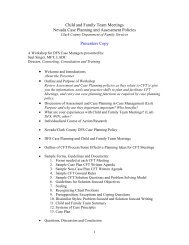Caseload and Workload Management - Child Welfare Information ...
Caseload and Workload Management - Child Welfare Information ...
Caseload and Workload Management - Child Welfare Information ...
Create successful ePaper yourself
Turn your PDF publications into a flip-book with our unique Google optimized e-Paper software.
<strong>Caseload</strong> <strong>and</strong> <strong>Workload</strong> <strong>Management</strong> www.childwelfare.gov<br />
For more research-based <strong>and</strong> practical<br />
“how-to” information on recruitment <strong>and</strong><br />
retention strategies used in the field, see:<br />
• Strategies Matrix Approach to<br />
Recruitment <strong>and</strong> Retention Techniques<br />
(SMARRT Manual), produced by the<br />
Western Regional Recruitment <strong>and</strong><br />
Retention Project<br />
• Training Series: Staff Retention in <strong>Child</strong><br />
<strong>and</strong> Family Services developed by<br />
Michigan State University School of<br />
Social Work<br />
• Workforce Tools featured on the <strong>Child</strong><br />
<strong>Welfare</strong> <strong>Information</strong> Gateway website<br />
Improving Worker effectiveness<br />
Agencies also address workload management<br />
through practices that aim to improve the<br />
efficiency <strong>and</strong> effectiveness of workers, so that<br />
once in place, staff can h<strong>and</strong>le more cases or<br />
work in less time. Strategies include:<br />
• training <strong>and</strong> professional development.<br />
Well-trained staff are able to complete<br />
tasks accurately <strong>and</strong> in a timely manner. In<br />
addition, studies suggest that educational<br />
programs provide workers with both<br />
competencies <strong>and</strong> increased commitment<br />
to their jobs, which are associated with<br />
retention (Zlotnik et al., 2005). Agencies<br />
are delivering a variety of training initiatives<br />
to build competencies <strong>and</strong> align skills with<br />
new practice models. Some States have<br />
formed university-agency partnerships<br />
This material may be freely reproduced <strong>and</strong> distributed. However, when doing so, please credit <strong>Child</strong> <strong>Welfare</strong><br />
<strong>Information</strong> Gateway. Available online at www.childwelfare.gov/pubs/case_work_management/<br />
that provide training <strong>and</strong>, in some cases,<br />
funding for child welfare staff to pursue<br />
graduate social work degrees (e.g., New<br />
York’s Social Work Education Consortium).<br />
• supervision. Good supervision helps<br />
workers gain knowledge <strong>and</strong> build the<br />
skills needed to conduct their work more<br />
effectively <strong>and</strong> efficiently. In addition,<br />
research points to supportive supervision<br />
as a critical factor in reducing turnover<br />
(Zlotnik et al., 2005; Juby & Scannapieco,<br />
2007; GAO, 2003.) Agencies are working<br />
to reduce staff/supervisor ratios, build<br />
supervisor skills, <strong>and</strong> improve the<br />
supervisor-caseworker relationship through<br />
supervisory training, coaching initiatives,<br />
mentoring opportunities, <strong>and</strong> feedback<br />
mechanisms.<br />
• design teams. Bringing together staff<br />
of every level from frontline workers <strong>and</strong><br />
supervisors up through managers <strong>and</strong><br />
administrators, design teams in New<br />
York State <strong>and</strong> elsewhere are used first to<br />
identify workforce issues <strong>and</strong> their causes<br />
<strong>and</strong> then to develop <strong>and</strong> implement<br />
workable solutions.<br />
• tools <strong>and</strong> technology. Agencies are using<br />
current technologies <strong>and</strong> mobile devices<br />
to help workers document casework more<br />
efficiently, access information that supports<br />
decision-making, <strong>and</strong> make use of waiting<br />
time. For example, workers in parts of<br />
Texas, Wisconsin, <strong>and</strong> Oklahoma take tablet<br />
PCs into the field to aid in streamlined<br />
documentation; workers in Vermont carry<br />
cell phones that not only offer telephone<br />
service but also email, scheduling, <strong>and</strong><br />
modem functions; <strong>and</strong> workers in Iowa are<br />
using SACWIS as a case management tool<br />
<strong>and</strong> resource for decision-making.<br />
6
















